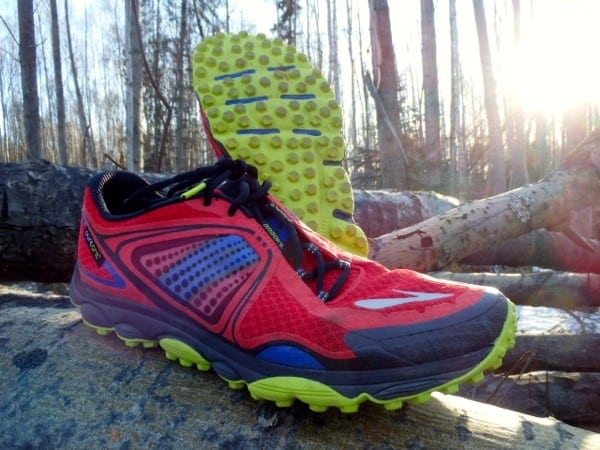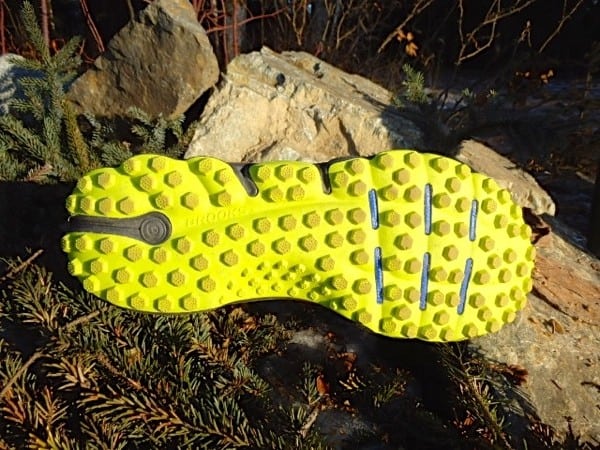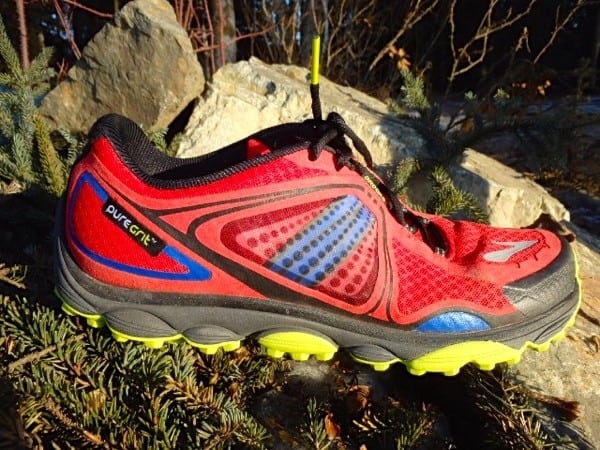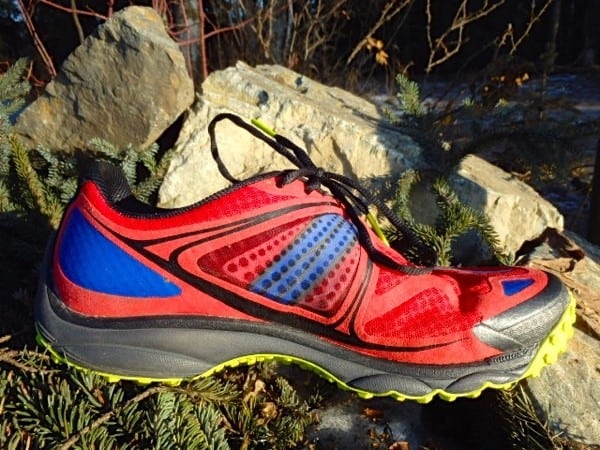Our Favorite Trail Running Shoes
Check out our Best Trail Running Shoes article to learn about our current favorite trail running shoes!
Brooks PureGrit 3 Review
[Editor’s Note: This review was composed by Alaskan trail runner and guest reviewer Kyle Emery. We’ve previously reviewed the original Brooks PureGrit and the Brooks PureGrit 2.]
The Brooks PureGrit 3 ($120) introduced changes resulting in a superb redesign that fulfills the promise that previous models only hinted at. I have run two pairs of PureGrit 2’s into the ground. While they were solid pairs of trail running shoes, I would never describe them as “great,” especially in comparison to the new PureGrit3. This review focuses on updates to the shoe from its previous versions.

The Brooks PureGrit 3. All photos: iRunFar/Kyle Emery
Outsole
The most obvious redesign to the shoe is on the outsole. The new outsole has one of the most aggressive treads I’ve seen on a trail running shoe. It’s covered with hexagon-shaped lugs that are made of a gripping rubber that Brooks claims was inspired by rock-climbing shoes. Even though the tread is very aggressive, it does not take away from the comfort of the shoe. With the aggressive tread and comfortable sole, you’ll be able to run over rugged trails for hours.
The only potential downside to the rubber is that it deteriorates quickly. So far I’ve run about 150 miles in the PureGrit3s and some of the lugs are already showing signs of wear, despite most of those miles being on soft snow. I would expect any pavement, gravel, or treadmill miles would wear down the tread on these shoes even faster. According to Brooks, these shoes are only expected to last approximately 250 to 300 miles, so perhaps this amount of wear is normal for these shoes.
Brooks has created an innovation they call the “Forefoot Propulsion Plate,” which is their term for the rock plate and three grooves that are built into the forefoot of the sole. It is intended to “maximize energy return,” but I personally don’t notice this feature while running. However, the introduction of a rock plate to the PureGrit line is a welcome addition. To protect your feet even more, the Brooks designers also put in a toe guard which I can personally say works great!

The Brooks PureGrit 3 outsole.
Upper
Brooks made some pretty significant changes to the design of the upper on the PureGrit 3, the most obvious being the lace pattern. The purpose of an off-centered lace pattern is to distribute the pressure from the laces over a larger area of the foot, instead of having the pressure focused on the bones on the top of the foot. The PureGrit 2 had laces that were very off-centered and it was a comfortable design. The Pure Grit 3’s lace pattern is closer to the top of the foot, but is still off-centered enough to maintain the comfort it was designed for.
The second major overhaul is the design of the shoe tongue. The PureGrit 2 featured what I consider a “semi-gusseted” tongue (meaning one side of the tongue was connected to the rest of the shoe, while the other was not). The PureGrit 3 has an un-gusseted tongue. I know some people were upset to see this change, but I actually like the new tongue design. There were some instances when the gusseted tongue on the PureGrit 2 pinched my ankles. The new tongue design stays in place just as well as the gusseted tongue and is more comfortable.
The single best update to the shoe is to the infamous “Nav Band.” This odd piece of material was in previous versions of the PureGrit, but the function, other than aesthetics, wasn’t clear. The new Nav Band differs from previous versions by completely wrapping around the upper instead of only wrapping around halfway. Now the Nav Band provides a snug, comfortable fit around the midfoot. This makes the PureGrit 3 feel light, fast, and responsive.

The Brooks PureGrit 3 lateral upper.
The Ride and the Midsole
I found some major differences in the fit of the PureGrit 3 versus the PureGrit 2. In my opinion the changes are entirely for the better. The best change for me is a slightly narrowed toe box. This was an upgrade for me since the PureGrit 2 had a toe box that was a little too large for me. The PureGrit 2’s larger toe box would occasionally give me blisters during longer trail runs. The only thing I dislike about the fit of the PureGrit 3 is the heel. I have a narrow heel and the heel of the shoe is definitely a loose fit. It is not enough to cause blisters or discomfort for me, but it could cause problems for others.
The PureGrit 3 keeps the 4mm-drop design that the PureGrit line was founded on. The difference between the PureGrit 3 and its predecessors is that it has more cushioning. Even though the shoe is designed with a 4mm drop, the cushioning doesn’t make it feel like a minimalist shoe. Brooks incorporated much more of their BioMoGo DNA cushioning into the PureGrit 3. I feel like the additional cushioning is a great update, but it definitely moves the PureGrit line farther away from its minimalist roots.
FYI: Their oddly named BioMoGo midsole is built from a biodegradable material that Brooks developed in an effort to make their shoes more ecofriendly. It takes approximately 20 years to break down in a landfill, as opposed to most plastic midsoles that can take 1000-plus years. I can’t tell any difference in how the material runs compared to traditional material but it’s neat technology!

The Brooks PureGrit 3 medial upper.
Overall Impressions
Brooks did a great job with the PureGrit 3 by keeping the vision of quality while upgrading features that were lacking in previous models. It has been an absolute joy running through the forest with them. I would highly recommend this shoe to anyone who likes the feel of a minimalist shoe, but likes having a bit more cushioning for longer runs. The PureGrit 3 is perfect for anyone looking to get on the trail and “Run Happy!”
Call for Comments (from Meghan)
- Have you run in the Brooks PureGrit 3’s? What are your thoughts on its ride and feel?
- If you ran in previous versions of the PureGrit, what do you think of the updates Brooks has made with this third version?
- In particular, what do you think of the increased cushioning of the PureGrit 3’s as compared to previous models?
